80 and 160 micrograms/dose inhalation spray, solution
Ciclesonide
1. What Alvesco is and what it is used for
What Alvesco is:
Alvesco is a clear and colorless aerosol spray that you inhale through your mouth and into your lungs. It is a preventative medicine (a corticosteroid or cortisone ) that must be taken every day and only works when it has reached the lungs.
The active substance in this medicine is cyclonesonide. (For other ingredients, see section 6 ).
What Alvesco is used for:
This medicine is used to control chronic asthma in adults and adolescents (12 years and older).
It helps you breathe easier by reducing the symptoms of asthma and reducing the risk of asthma attacks. The effect builds up over time, and therefore you must take this medicine every day, even when you are feeling well.
This medicine is not suitable for use in an acute attack of shortness of breath. In such attacks, use only your fast-acting asthma medication.
2. What you need to know before using Alvesco
Do not use Alvesco
if you are allergic (hypersensitive) to cyclonesonide or any of the other ingredients of this medicine (listed in section 6).
Be especially careful with Alvesco
- Before starting treatment with this medicine, tell your doctor about:
you have ever received treatment, or are undergoing treatment, for pulmonary tuberculosis (TBC) or fungal, viral, or bacterial infection.
Ask your doctor if you are unsure. It is important to ensure that Alvesco is the right medicine for you.
During treatment with Alvesco, you should contact a doctor immediately if:
- you may have difficulty breathing and worsening symptoms (cough, shortness of breath, wheezing, chest tightness, increased breathing sounds (rookie), or other symptoms of the narrower trachea) – use your fast-acting asthma medication which normally provides rapid improvement.
- you wake up at night from your symptoms.
- The symptoms are not relieved by your fast-acting asthma medication.
The doctor decides on continued treatment.
Special patient groups
Patients with severe asthma are at risk of acute asthma attacks. These patients may have regular and thorough asthma checks, including lung function tests.
Patients already taking cortisone tablets (corticosteroid tablets):
Alvesco can be used as a replacement for your tablets or to reduce the number of tablets you need to take. Follow your doctor’s instructions carefully.
- You should start reducing the number of cortisone tablets about a week after you start inhaling Alvesco.
- The number of tablets you are going to take will be tapered off gently over a period of time.
- During this period, you can sometimes feel generally unwell. It is important that you continue to use Alvesco and slowly reduce the number of tablets you take.
- If you get severe symptoms such as nausea, vomiting, diarrhea, or fever, consult a doctor.
- During the transition from tablets to inhaled cortisone, sometimes milder allergies can appear, such as rhinitis ( inflammation of the nose) or eczema (itchy, red skin).
- If you have switched from tablets, the risk of adrenal insufficiency associated with cortisone tablets will persist for some time. Symptoms of adrenal insufficiency (eg dizziness, fainting, nausea, loss of appetite, depression, decreased body hair, inability to cope with stress, weakness, headache, memory problems, allergies, food cravings, and high blood sugar) may persist for some time.
- You may need to see a specialist find out to what extent adrenal function is impaired.
- Your doctor will also regularly check your adrenal function.
- During stressful periods, e.g. If you are having surgery or have worsening asthma attacks, you may need extra cortisone tablets. Then you should always carry a steroid warning card with this information.
Patients with liver or kidney disease
There is no need to adjust the dose of a cyclesonide if you have liver or kidney problems. If you have severe liver disease, your doctor will examine you carefully for any side effects due to disturbed steroid production.
Children under 12 years of age:
This medicine is not recommended for children under 12 years of age due to a lack of knowledge about possible effects.
Other medicines and Alvesco
Before using Alvesco, tell your doctor if you are currently being treated for fungal or viral infection with medicines containing:
- ketoconazole
- itraconazole
- ritonavir
- nelfinavir
These medicines may potentiate the effects of Alvesco in such a way that the risk of side effects cannot be ruled out.
Tell your doctor or pharmacist if you are taking or have recently taken any other medicines, including medicines obtained without a prescription.
Use of this medicine with food and drink
Alvesco is not affected by food and drink.
Pregnancy, breastfeeding, and fertility
Tell your doctor if you are pregnant, want to become pregnant, or if you are breast-feeding.
- As there is insufficient information on the effects of Alvesco on pregnant women, your doctor will discuss the benefits and risks of using Alvesco with you.
- During pregnancy, Alvesco should only be taken when the potential benefit to the mother outweighs the potential risk to the fetus. If your doctor decides that you can continue to use Alvesco, you will be given the lowest possible dose of ciclesonide required to control your asthma.
- The adrenal function will be closely monitored in children of mothers taking cortisone during pregnancy.
- Talk to your doctor if you want to use Alvesco while breast-feeding.
- It is not known if inhaled cyclonesonide passes into breast milk.
- Prescribing Alvesco to breast-feeding women is therefore considered only if the expected benefit to the mother is considered to outweigh the potential risk to the baby.
Ask your doctor or pharmacist for advice before taking any medicine.
Driving and using machines
Alvesco and its ingredients have no or negligible effect on the ability to drive and use machines.
3. How to use Alvesco
Always use this medicine exactly as your doctor has told you. Ask your doctor or pharmacist if you are unsure.
- If you have just started taking this medicine instead of, or together with, cortisone tablets, see section 2, Patients already taking cortisone tablets (corticosteroid tablets).
How much Alvesco should you take each day?
Your doctor has told you how much medicine to take each day. This depends on how much you need.
- The recommended dose of Alvesco is 160 micrograms once daily, leading to asthma control in most patients.
- In some patients, a lower dose of 80 micrograms once a day may be sufficient to effectively control asthma.
- For patients suffering from a severe worsening of asthma symptoms, it may be necessary to increase the dose for a short period. This can mean up to 640 micrograms per day, taken as 320 micrograms twice a day. There are no data showing additional effect with these higher doses after 3 months.
If necessary, your doctor may also prescribe cortisone tablets and/or, in case of infection, antibiotics.
- Your doctor will set your dose to the lowest dose needed to control your asthma.
- You should start to notice an improvement in your symptoms (wheezing, wheezing, and coughing) within 24 hours.
When to use the Alvesco inhaler?
In most cases, either in the morning or in the evening – one or two puffs once a day. Follow your doctor’s instructions very carefully. It is important that you take Alvesco regularly every day, even if you feel better.
If you notice that you need to use your fast-acting asthma medication more than 2-3 times a week, contact your doctor for a review of your medication.
How do you use the Alvesco inhaler?
It is important that a doctor, nurse, or pharmacist has shown you how to use the inhaler correctly. With the right technology, you will get the right amount of medicine for your lungs. Use this leaflet as a memory aid.
You can practice in front of the mirror the first few times until you are sure you are using the inhaler correctly. Make sure that the medicine puff does not leak above, below, or next to the mouth.
If the inhaler is new or if you have not used it for a week or more, you must check it before use. Remove the protective cap from the nozzle and press the container in the inhaler three times so that three puffs come out into the air – in the direction from you.
You do not need to shake the inhaler before using it. The medicine already has the form of a very finely divided solution that is mixed so that you get the right dose at each puff.
When inhaling, either sit or stand.
Follow the instructions carefully and take the pictures for help.
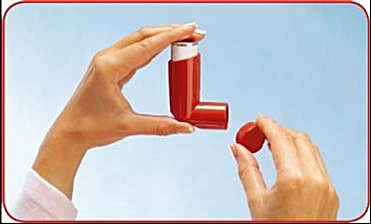
1. Remove the nozzle cover and check on the inside and outside that the nozzle is clean and dry.
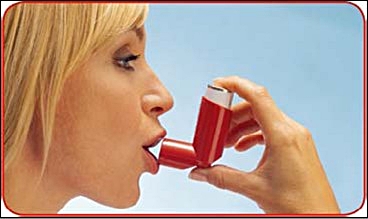
2. Hold the inhaler up and down (with the bottom of the container facing up) with your index finger on the bottom of the container and your thumb on the underside, under the mouthpiece.
3. Breathe out as much as you can without straining yourself. Do not exhale into the inhaler.
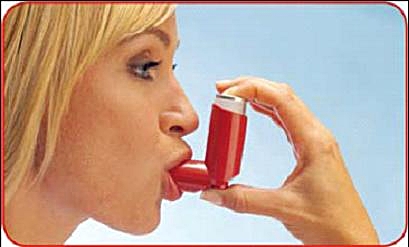
4. Put the nozzle in your mouth and close your lips tightly around it.
5. Just as you start inhaling through your mouth, press the top of the inhaler so that there is a puff. Continue to inhale slowly and deeply. Make sure that the medicine puff does not leak above, below, or next to the mouth.
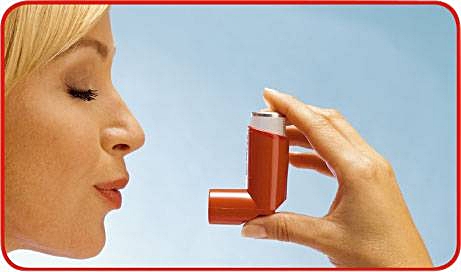
6. Hold your breath, remove the inhaler from your mouth and remove your finger from the top of the inhaler. Continue to hold your breath for about ten seconds or as long as it feels good. Exhale slowly through your mouth. Do not exhale into the inhaler.
It is important that you are not in a hurry with steps 3 to 6.
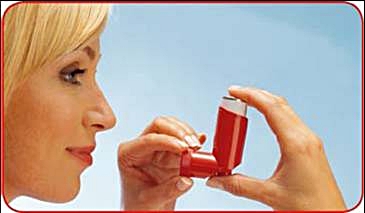
7. If you are going to take another puff, wait for about half a minute and then repeat steps 3 to 6.
8. When you are done, always put the protective cap on the nozzle so that it is kept clean from dust. Attach it firmly so that it clicks into place.
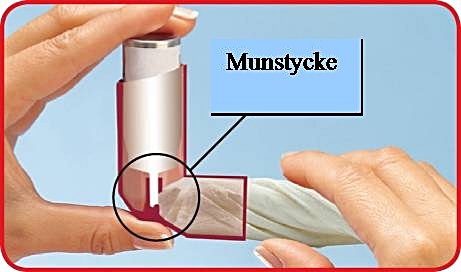
9. For hygiene reasons, you should
- once a week clean the inhaler nozzle with a dry paper towel on both the inside and outside,
- use a dry, folded paper towel and wipe over the small hole on the front where the medicine comes out,
- do not use water or other liquid.
With the right technology, you get the right amount of Alvesco for your lungs every time you use the inhaler. Your doctor will check your inhalation technique regularly to make sure that the treatment has the best possible effect.
When the tank is completely empty, you will feel or hear that there is no propellant.
If your breathing becomes wheezing or if you feel cramped in the chest after using Alvesco:
- Do not take more puffs.
- Use your fast-acting asthma medicine to breathe easier.
- Contact a doctor immediately.
Your doctor may recommend that you use a spacer if you find it difficult to use the inhaler. The spacer that fits the Alvesco inhaler is called AeroChamber Plus ™. Follow the instructions for use if you are using AeroChamber Plus ™. Doctors or pharmacists can advise you on the spacer.
If you have used too much Alvesco
It is important that you take a dose as instructed by your doctor. Do not increase or decrease the dose without consulting a doctor. You do not need any special treatment if you have used too much Alvesco, but you should tell your doctor. When using high doses for a long time, it can not be ruled out that the adrenal function is reduced to a certain degree and it may be necessary to control the adrenal function.
If you forget to use Alvesco
If you forget to take Alvesco, just take the next dose at the right time. Do not take double the number of puffs to compensate for the missed dose.
If you stop using Alvesco
Even if you feel better, do not stop using Alvesco.
If you stop using this medicine, you must tell your doctor immediately.
4. Possible side effects
Like all medicines, Alvesco can cause side effects, although not everybody gets them.
If you notice any of the following serious side effects, stop using the medicine and contact your doctor immediately:
- severe allergic reactions such as swelling of the lips, tongue, and throat (may affect up to 1 in 1,000 people)
- allergic reactions: skin rash, redness, itching, hives, (may affect up to 1 in 100 people)
- coughing or wheezing that worsens after inhalation (may affect up to 1 in 100 people)
Other side effects observed with Alvesco are usually mild. In most cases, you can continue with the treatment. You may experience the following side effects:
Uncommon side effects (may affect up to 1 in 100 people):
- huskiness
- burning, inflammation, irritation, in mouth or throat
- cod (fungal infections of the mouth).
- headache.
- changed taste experience
- dry mouth or throat
- nausea or vomiting.
Rare side effects (may affect up to 1 in 1,000 people):
- palpitations ( palpitation )
- discomfort or pain in the abdomen
- high blood pressure
Has been reported (occurs in an unknown number of users):
- Sleep problems, depression, anxiety, restlessness, anxiety, feeling very hurried, and/or irritable. These side effects are more likely to occur in children.
Alvesco can affect the body’s normal production of corticosteroids, especially in patients taking high doses for a long time. These effects may include:
- Slow growth in young people.
- Osteoporosis.
- The possible haze of the eye’s lens (cataract/cataract) that causes blurred vision.
- Visual impairment due to abnormally high pressure in the eye (glaucoma/glaucoma).
- Moon-shaped face, weight gain in the upper part of the body, and narrower arms and legs (cushingoid features of Cushing’s syndrome).
Adolescents who are treated for a long time should go for regular length checks with a doctor. In case of growth retardation, your doctor will, if possible, adjust dose one to the lowest dose one needed to still control asthma effectively.
Cortisone tablets can cause more side effects than inhaled cortisone, such as Alvesco. If you have taken cortisone tablets before using Alvesco or during treatment with Alvesco, the risk of side effects from the tablets may persist for some time. Regular medical check-ups will ensure that the dose of Alvesco you are taking is the right dose for you. Regular medical check-ups also mean that any side effects are detected early and thus reduce the risk of them getting worse.
Remember:
If any of the side effects gets serious, or if you notice any side effects not listed in this leaflet, please tell your doctor or pharmacist.
Reporting of side effects
If you get any side effects, talk to your doctor, pharmacist, or nurse. This includes any possible side effects not listed in this leaflet. You can also report side effects directly to the Medical Products Agency, www.lakemedelsverket.se. By reporting side effects, you can help increase drug safety information.
5. How to store Alvesco
Keep out of sight and reach of children.
Do not use the inhaler after the expiry date which is stated on the carton after EXP and on the label after EXP. The expiration date is the last day of the specified month.
The container contains a liquid under pressure. The container must not be exposed to temperatures above 50 ° C.
The container must not be punctured, damaged, or burned, even if it appears to be empty.
As with most inhaled medicinal products in pressure vessels, the treatment effect of Alvesco may decrease when the container is cold. However, Alvesco provides a steady dose from -10 ° C to + 40 ° C.
If your doctor decides that you should stop treatment or if the inhaler is empty, return it to the pharmacist for safe disposal. This is important because there may be small amounts of medicine left in the container, even if you think it appears to be empty.
6. Contents of the packaging and other information
Content declaration
- The active substance is cyclonesonide. Each pressure on the container produces a puff ( dose delivered through the mouthpiece) containing either 80 or 160 micrograms of cyclonesonide
- The other ingredients are anhydrous ethanol and propellant (HFA-134a, norflurane).
What the medicine looks like and the contents of the pack
Alvesco contains a clear and colorless liquid in an aluminum pressure vessel which delivers a carefully measured dose of ciclesonide in the form of a spray through the nozzle.
Pack sizes:
Inhaler with 30 doses is.
Inhaler with 60 doses is.
Inhaler with 120 doses is.
An inhaler, regardless of strength, contains a sufficient amount for 30, 60, or 120 doses (puffs). Depending on how many puffs per day your doctor has recommended that you use:
- If the 30- dose inhaler contains enough medicine for two to four weeks
- If the 60- dose inhaler contains enough medicine for one to two months
- If the 120- dose inhaler contains enough medicine for two to four months.
Not all pack sizes may be marketed.
Marketing Authorisation Holder
Covis Pharma Europe BV
Gustav Mahlerpein 2
1082MA Amsterdam The
Netherlands
Manufacturer
Takeda GmbH
Byk-Gulden-Str. 2
D-78467 Constance
Germany